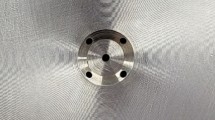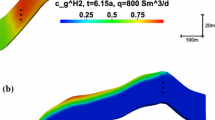A numerical study has been made of the intensification of combustion in hydrogen-oxygen mixtures with a low-temperature nonequilibrium plasma, when the concentration of the active particles in the mixture (atoms, radicals, ions, and excited particles) is much higher than their equilibrium concentrations. Primary emphasis has been placed on the influence of higher-than-average concentrations of electronically excited O2(a 1Δg) molecules and O( 1Δ) atoms on the acceleration of the process of ignition. Electron-beam irradiation of the fuel mixture and the action of a high-voltage nanosecond discharge on it were selected for comparison of the efficiency of different types of plasma initiation of combustion.
Similar content being viewed by others
References
H. Taguchi, H. Kobayashi, T. Kojima, A. Ueno, S. Imamura, M. Hongoh, and K. Harada, Research on hypersonic aircraft using pre-cooled turbojet engines, Acta Astronaut., 73, No. 1, 164–172 (2012).
D. Cecere, A. Ingenito, E. Giacomazzi, L. Romagnosi, and C. Bruno, Hydrogen/air supersonic combustion for future hypersonic vehicles, Int. J. Hydrogen Energy, 36, No. 18, 11969–11984 (2011).
S. Brieschenk, S. O’Byrne, and H. Kleine, Laser-induced plasma ignition studies in a model scramjet engine, Combust. Flame, 160, No. 1, 145–148 (2013).
S. M. Starikovskaia, Plasma assisted ignition and combustion, J. Phys. D: Appl. Phys., 39, No. 16, R265–R299 (2006).
A. I. Pushkarev and G. E. Remnev, Initiation of oxidation of hydrogen by a pulsed electron beam, Fiz. Goreniya Vzryva, 41, No. 3, 46–51 (2005).
T. Ombrello, S. H. Won, Y. Ju, and S. Williams, Flame propagation by plasma excitation of oxygen. Part II: Effect of O2(a 1Δ g ), Combust. Flame, 157, No. 10, 1916–1928 (2010).
N. A. Popov, Influence of nonequilibrium excitation on the ignition of hydrogen–oxygen mixtures, Teplofiz. Vys. Temp., 45, No. 2, 296–315 (2007).
A. S. Sharipov and A. M. Starik, Kinetic mechanism of CO–H2 system oxidation promoted by excited singlet oxygen molecules, Combust. Flame, 159, No. 1, 16–29 (2012).
N. A. Popov, Effect of singlet oxygen O2(a 1Δ g ) molecules produced in a gas discharge plasma on the ignition of hydrogen–oxygen mixtures, Plasma Sources Sci. Technol., 20, No. 045002, 1–11 (2011).
G. Ya. Gerasimov and O. P. Shatalov, Kinetic mechanism of combustion of hydrogen–oxygen mixtures, Inzh.-Fiz. Zh., 86, No. 5, 929–936 (2013).
L. B. Ibragimova and O. P. Shatalov, Rate constants of reactions for study of the combustion of oxygen–hydrogen mixtures involving excited atoms O(1D) and O(1S) and molecules O2(b 1 S), O2(a 1Δ), and OH(A2 S) (2013). http://www.chemphys.edu.ru/media/files/2013-03-12-001.pdf.
N. Washida, H. Akimoto, and M. Okuda, Formation of singlet state molecular oxygen in the reaction of H + O2, J. Phys. Chem., 82, No. 1, 18–21 (1978).
R. Atkinson, D. L. Baulch, R. A. Cox, J. N. Crowley, R. F. Hampson, and R. G. Hynes, Evaluated kinetic and photochemical data for atmospheric chemistry: Volume I — gas phase reactions of O x , HO x , NO x , and SO x species, Atmos. Chem. Phys., 4, No. 6, 1461–1738 (2004).
I. D. Clark and R. P. Wayne, Collisional quenching of O2(1Δ g ), Proc. Roy. Soc. London A, 314, No. 1516, 111–127 (1969).
K. H. Becker, W. Groth, and U. Schurath, The quenching of metastable O2(1Δ g ) and O2(1Σ g +) molecules, Chem. Phys. Lett., 8, No. 3, 259–262 (1971).
J. R. Podolske and H. S. Johnson, Rate of the resonant energy-transfer reaction between molecular oxygen O2(1Δ g ) and perhydroxyl (HOO), J. Phys. Chem., 87, No. 4, 628–634 (1983).
J. T. Herron and D. S. Green, Chemical kinetics database and predictive schemes for nonthermal air plasma chemistry. Part II. Neutral species reactions, Plasma Chem. Plasma Process., 21, No. 3, 459–481 (2001).
A. A. Konnov, Remaining uncertainties in the kinetic mechanism of hydrogen combustion, Combust. Flame, 152, No. 4, 507–528 (2008).
R. F. Heidner, C. E. Gardner, T. M. El-Sayed, G. I. Segal, and J. V. V. Kasper, Temperature dependence of O2(1Δ)+O2(1Δ) and I(2P1/2)+O2(1Δ) energy pooling, J. Chem. Phys., 74, No. 10, 5618–5627 (1981).
J. Shi and J. R. Barker, Kinetic studies of the deactivation of O2(1Σ g +) and O(1D), Int. J. Chem. Kinet., 22, No. 12, 1283–1301 (1990).
S. P. Sander, J. Abbatt, J. R. Barker, et al., Chemical kinetics and photochemical data for use in atmospheric studies. Evaluation No. 17, JPL Publication 10-6, Jet Propulsion Laboratory, Pasadena (2011); http://jpldataeval.jpl.nasa.gov.
A. Burcat and B. Ruscic, Third Millennium Ideal Gas and Condensed Phase Thermochemical Database for Combustion with Updates from Active Thermochemical Tables, ANL-05/20 and TAE 960, Technion-IIT, Aerospace Eng. and Argonne National Laboratory, Chemistry Division (2005).
V. Ya. Basevich and A. A. Belyaev, Calculation of the increase in the velocity of a hydrogen-oxygen flame on additions of singlet oxygen, Khim. Fiz., 8, No. 8, 1124–1127 (1989).
S. H. Mousavipour and V. Saheb, Theoretical study on the kinetic and mechanism of H + HO2 reaction, Bull. Chem. Soc. Jpn., 80, No. 10, 1901–1913 (2007).
A. Starik and A. Sharipov, Theoretical analysis of reaction kinetics with singlet oxygen molecules, Phys. Chem. Chem. Phys., 13, No. 36, 16424–16436 (2011).
S. W. Mayer and L. Schieler, Activation energies and rate constants computed for reactions of oxygen with hydrocarbons, J. Phys. Chem., 72, No. 7, 2628–2631 (1968).
P. Borrell and D. S. Richards, Quenching of singlet molecular oxygen O2(a 1Δ g ) and O2(b 1 Σ g ) by H, HCl and HBr, J. Chem. Soc. Faraday Trans. 2, 85, No. 9, 1401–1411 (1989).
L. T. Cupitt, G. A. Takacs, and G. P. Glass, Reaction of hydrogen atoms and O2(1Δ g ), Int. J. Chem. Kinet., 14, No. 5, 487–497 (1982).
V. Ya. Basevich and V. I. Vedeneev, Rate constant of the reaction H + O2(a 1Δ g ) = OH + O, Khim. Fiz., 4, No. 8, 1102–1106 (1985).
D. I. Slovetskii, Mechanisms of Chemical Reactions in a Nonequilibrium Plasma [in Russian], Nauka, Moscow (1980).
R. J. Kee, F. M. Rupley, E. Meeks, and J. A. Miller, Chemkin- III: A Fortran Chemical Kinetics Package for the Analysis of Gas-Phase Chemical and Plasma Kinetics, Technical Report SAND96-8218, Livermore, Sandia National Laboratories (1996).
V. V. Smirnov, O. M. Stel’makh, V. I. Fabelinskii, D. N. Kozlov, A. M. Starik, and N. S. Titova, On the influence of electronically excited oxygen molecules on combustion of hydrogen–oxygen mixture, J. Phys. D: Appl. Phys., 41, No. 19, 192001(6pp).
A. A. Chukalovsky, K. S. Klopovsky, M. A. Liberman, Y. A. Mankelevich, N. A. Popov, O. V. Proshina, and T. V. Rakhimova, Study of singlet delta oxygen O2(1Δg) impact on H2–O2 mixture ignition in flow reactor: 2D modeling, Combust. Sci. Technol., 184, Nos. 10–11, 1768–1786 (2012).
C. Willis and A. W. Boyd, Excitation in the radiation chemistry of inorganic gases, Int. J. Radiat. Phys. Chem., 8, No. 1, 71–111 (1976).
B. D. Sharpee and T. G. Slanger, O(1D2–3P2,1,0) 630.0, 636.4, 636.4, and 639.2 nm forbidden emission line intensity ratios measured in the Terrestrial nightglow, J. Phys. Chem. A, 110, No. 21, 6707–6710 (2006).
A. D. Snyder, J. Robertson, D. L. Zanders, and G. B. Skinner, Shock tube studies of fuel-air ignition characteristics, Technical report AFAPL-TR-65-93, Air Force Aero-Propulsion Laboratory, Wright-Patterson (1965).
M. W. Slack, Rate coefficient for H + O2 + M = HO2 + M evaluated from shock tube measurements of induction times, Combust. Flame, 28, No. 1, 241–249 (1977).
G. Y. Gerasimov, Ionizing-radiation ignition of a hydrogen–air mixture, High Energy Chem., 36, No. 6, 370–373 (2002).
S. A. Bozhenkov, S. M. Starikovskaia, and A. Y. Starikovskii, Nanosecond gas discharge ignition of H2- and CH4-containing mixtures, Combust. Flame, 133, Nos. 1–2, 133–146 (2003).
D. Dautzenberg, Gamma-radiolysis of hydrogen–oxygen mixtures. Part I. Influences of temperature, vessel wall, pressure and added gases (N2, Ar, H2) on the reactivity of H2/O2 mixtures, Radiat. Phys. Chem., 33, No. 1, 61–67 (1989).
A. K. Pikaev, Modern Radiation Chemistry: Radiolysis of Gases and Liquids [in Russian], Nauka, Moscow (1986).
Author information
Authors and Affiliations
Corresponding author
Additional information
Translated from Inzhenerno-Fizicheskii Zhurnal, Vol. 87, No. 5, pp. 1022–1028, September–October, 2014.
Rights and permissions
About this article
Cite this article
Gerasimov, G.Y., Shatalov, O.P. Numerical Modeling of the Ignition of Hydrogen–Oxygen Mixtures Under Nonequilibrium Conditions. J Eng Phys Thermophy 87, 1063–1070 (2014). https://doi.org/10.1007/s10891-014-1108-z
Received:
Published:
Issue Date:
DOI: https://doi.org/10.1007/s10891-014-1108-z




